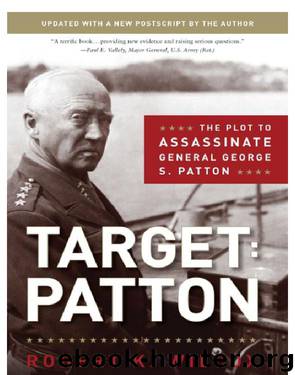Target Patton: The Plot to Assassinate General George S. Patton by Robert K. Wilcox

Author:Robert K. Wilcox [Wilcox, Robert K.]
Language: eng
Format: epub
Tags: Political Science, Political Ideologies, Conservatism & Liberalism, History, Modern, 20th Century
ISBN: 9781596980914
Google: se9tNjBVLqgC
Publisher: Regnery Publishing
Published: 2008-12-02T20:36:15+00:00
President Roosevelt, one sadly has to believe, had no idea how infiltrated Soviet spies were in his administration. (If he did know, that would be even worse.) What he believed to be a noble and time-has-come society—one needed to insure world peace—was actually a place of repression, assassination, and lies as bad as Wisconsin senator Joe McCarthy, however objectionable his methods might have been, portrayed in his denunciations.28 Even McCarthy, who frequently charged communists were rife in American society, did not know how bad things really were. He was not privy to the deepest secrets that are only now coming to light. The numbers of Communist agents reporting to Moscow and sympathizers aiding them in America at that time is staggering, probably reaching into the thousands. It included the American communist Party, now known to have been supplying the USSR with recruits.29 The result was a clandestine army, and not just in low, inconsequential jobs. There were Soviet spies in virtually every part of the U.S. government during the war, stealing secrets and influencing policy—all to aid Stalin and the USSR.
Americans spying for the Soviets were operating at the highest tiers; at State, Treasury, Justice, in the Congress, in the military, in the intelligence agencies, defense industries, the media, even in the White House with influence over the president. They were working in the country’s most secret science projects, such as Manhattan which was creating the atomic bomb. In fact, had it not been for a lucky change in the Democrat ticket for president in 1944, America would have emerged from the war with two Soviet spies heading major cabinet positions and a president, Henry Wallace, who believed, as they did, that communist Russia was the light of the world.
One of the reasons historians now know much of this is because of the Venona project, the secret wartime U.S. endeavor to read coded Russian diplomatic messages. The project was not declassified and made public until 1995, more than fifty years after it had been initiated. A lot of history has been written without it but the media, generally still locked into portraying the era as one of “McCarthyism” and “The Red Scare,” has done almost nothing to publicize Venona, which gives the lie to their shallow portrayal. As a result, the general public is still largely unaware of what the code-breaking operation shows.
Begun on a small scale in 1943 in response to fear that the Russians might be negotiating a secret peace with the Nazis, Venona continued under the National Security Agency until 1980 when it was finally halted but remained classified. From the beginning, the project, born under NSA forerunner, the army’s Signal Intelligence Service, was a hard, exasperating task conducted by a few dedicated individuals. The smallness probably reflected the pro-Soviet attitude in Washington at the time. Suspect the Soviets and you were suspected yourself. But such favoritism did not deter the Soviets. They were so pervasive in their U.S. spying that they were actually alerted by a spy within Venona shortly after the war and changed their codes thereafter.
Download
This site does not store any files on its server. We only index and link to content provided by other sites. Please contact the content providers to delete copyright contents if any and email us, we'll remove relevant links or contents immediately.
| Afghan & Iraq Wars | American Civil War |
| American Revolution | Vietnam War |
| World War I | World War II |
Waking Up in Heaven: A True Story of Brokenness, Heaven, and Life Again by McVea Crystal & Tresniowski Alex(37671)
Empire of the Sikhs by Patwant Singh(22974)
We're Going to Need More Wine by Gabrielle Union(18967)
Hans Sturm: A Soldier's Odyssey on the Eastern Front by Gordon Williamson(18483)
Leonardo da Vinci by Walter Isaacson(13181)
The Radium Girls by Kate Moore(11921)
Tools of Titans by Timothy Ferriss(8216)
Educated by Tara Westover(7941)
How to Be a Bawse: A Guide to Conquering Life by Lilly Singh(7391)
Permanent Record by Edward Snowden(5737)
The Last Black Unicorn by Tiffany Haddish(5558)
The Rise and Fall of Senator Joe McCarthy by James Cross Giblin(5228)
Promise Me, Dad by Joe Biden(5087)
The Wind in My Hair by Masih Alinejad(5033)
A Higher Loyalty: Truth, Lies, and Leadership by James Comey(4843)
The Crown by Robert Lacey(4722)
The Iron Duke by The Iron Duke(4291)
Joan of Arc by Mary Gordon(4013)
Stalin by Stephen Kotkin(3875)
